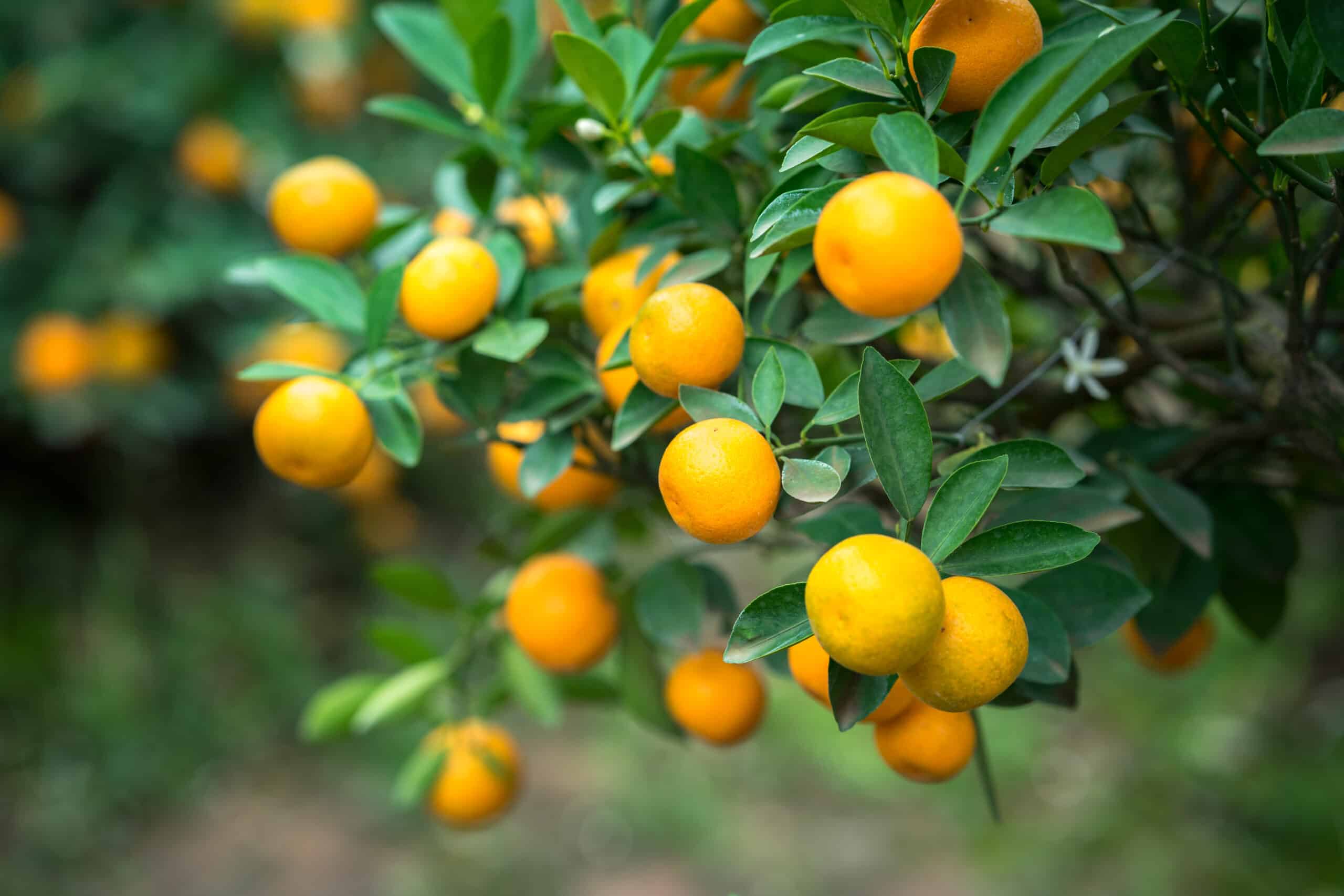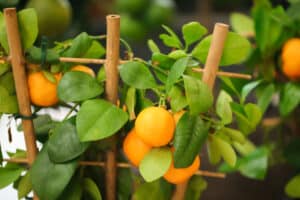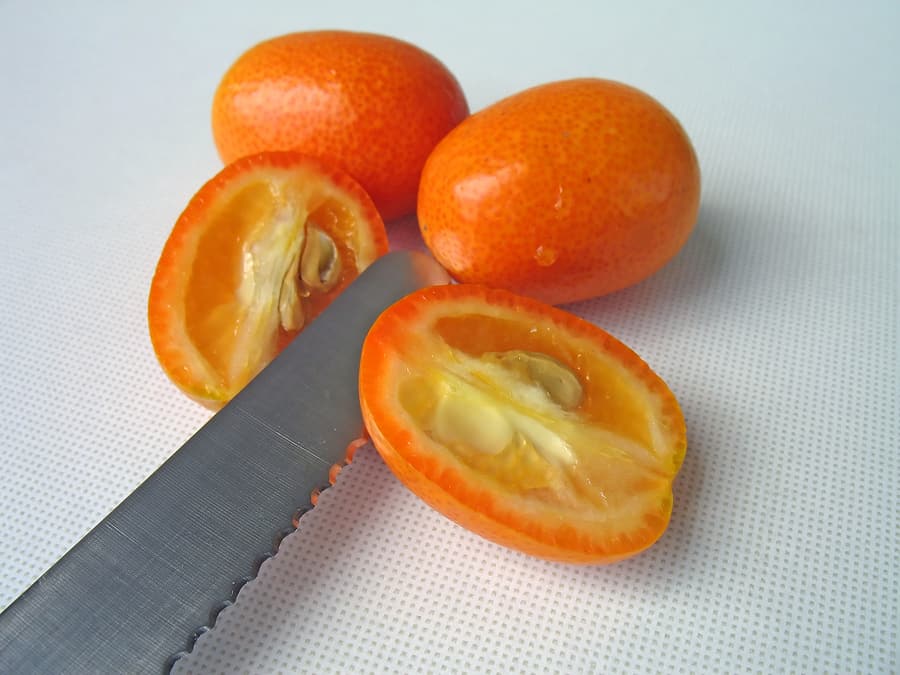Kumquats and kumquat hybrids look like miniature oranges. Most kumquats are rarely more than an inch long.
Kumquats grow best where temperatures are relatively high; kumquats prefer warm to hot summer days but also do best where nighttime temperatures dip into the low 50sF; these temperature differentials are essential during the ripening process to develop good flavor and color.
Related article:

Kumquats flower in the heat of midsummer, unlike other citrus trees. They start to ripen in mid-fall in warm and hot summer climates; they mature in late winter in cooler regions. Fruits can hang on the tree for up to a year without any decrease in quality.
How to eat kumquats
Kumquats can be eaten fresh out of hand whole—rind and all. The skin of the kumquat is sweeter than the flesh.
Roll a kumquat between your fingers to mingle the sweet skin and tart flesh, then eat the whole fruit or slice it and add it to fruit salads. Kumquats can be used to make preserves, marmalades, relishes, and sauces. Kumquats can also be baked into bread and candied.
Best climate for growing kumquats
The amount of heat during the growing period determines the size and juiciness of kumquat fruit. In Florida where it is hot and humid through the summer, kumquats are larger and juicier than those grown along coastal California. California and Arizona desert growing regions produce large kumquats. Fruit tends to be sweet and juicer when grown in areas with humid summers.
Kumquats are more cold-tolerant than any other citrus. They are a good choice to grow in the northernmost areas of the citrus belt. Kumquat trees are hardy to at least 18°F; the fruit, like other citrus fruits, will be damaged by temperatures near freezing.

See also: How to Grow Citrus for kumquat growing tips.
About kumquats
Dwarf kumquat trees will grow 3 to 6 feet tall; standard trees will grow about twice that size. Dwarf varieties are excellent container plants.
Because kumquats are hardier than other citrus, kumquats have been bred with lemons and oranges in an effort to create lemon-like and orange-like fruits that can withstand cold. Some kumquat hybrids are more cold-tolerant than true kumquats.
Kumquats are not in the genus Citrus; they are in the genus Fortunella.
Kumquat varieties
‘Meiwa’: sweet rind and flesh; slightly juicy, moderately acid; bright orange rind and flesh; best for eating fresh, rind and all; larger and sweeter than ‘Nagami’, more tender rind than ‘Nagami’; rind is medium-thick; not necessary to peel; few seeds; use to make candied fruit and marmalades; small to medium size tree; may be a natural kumquat hybrid; ideal for containers; fruit holds well on the tree; ‘Meiwa’grows well in all citrus-growing regions; very cold tolerant; can produce sweet fruit in cool coastal climates.
‘Nagami’: rind is mildly sweet; orange pulp contains little juice which is moderately acidic and sour; small, oval fruit; medium-thick, light orange rind; one or two seeds; use in preserves, making syrup, for candying, and making marmalade; compact tree-shrub like plant with dense foliage and no thorns; very hardy; fruit holds on tree for several months without loss of flavor; ‘Nagami’ grows well in all citrus-growing regions; cold tolerant; yield is better in hot summer climates than in cooler regions.
‘Marumi’: sweet-tart flesh; the peel is sweeter than ‘Nagami’; the pulp is more acidic than ‘Nagami’; round fruit, slightly smaller than ‘Meiwa’ but similar; few seeds; slightly thorny small tree; grown mainly in Florida.
Kumquat hybrids
Kumquat hybrids are a good choice in cool climates where kumquats and citrus cannot be grown.

Calamondin: a natural hybrid generally considered a cross between a kumquat and sour mandarin; often considered part of the loose-skinned mandarin group, but the fruit has kumquat-like qualities; acidic, juicy, orange pulp; small fruit with bright orange-red rind; few seeds; used as a flavoring for foods and drinks much like lemons and limes; hangs well on the tree past maturity.
Citrangequat: cross between citrange and kumquat; citrange is a cross between the sweet orange and the trifoliate orange; small oval fruit with slight neck; reddish-orange rind; tight skin; few to no seeds; sharply acid flavor; primarily used in marmalades and other foods calling for a sour-acid flavor; fruit will hang on the tree past maturity; upright, compact tree; nearly thornless; tree will survive in cold areas where kumquats will not survive.
Limequat: a hybrid cross between a ‘Mexican’ lime and a kumquat; limequat is a good lime substitute and much more cold hardy than the lime; fruit slightly orange when fully ripe; all limequats are everblooming; main crop setting in winter; fruit does not require heat to ripen; trees grow 3 to 4 feet tall. Variety ‘Eustis’ is a hybrid between a ‘Mexican’ lime and ‘Marumi’ kumquat; has oval fruit smaller than Mexican lime; yellow rind; thin skin; difficult to peel; few to many seeds; has the flavor, juiciness, and aroma of lime; can hang on the tree for several months before losing flavor; hardier than a lime; grows well in all citrus-growing regions. Variety ‘Lakeland’ is similar to ‘Eustis’; fruit matures from fall to spring. Variety ‘Tavares’ is a hybrid between ‘Mexican’ lime and ‘Nagami’ kumquat; large, oblong fruit; pronounced neck; turns orange-yellow when mature; juicy, acidic with lime-like flavor; good lime substitute; the tree is more compact than ‘Eustis’.
Mandarinquat ‘Indio’: mandarin-kumquat hybrid; sweet orange rind, tart orange pulp; large, bell-shaped fruit; compact tree; grows well in all citrus-growing regions.
Orangequat ‘Nippon’: a cross between the ‘Meiwa’ kumquat and the Satsuma mandarin; tasty kumquat-like fruit; the pulp is juicy and slightly acidic and tart; round to oval fruit with pronounced neck; fruit is larger than a kumquat; bright red-orange sweet rind; few seeds; not difficult to peel; overall flavor sweeter than kumquat; eat fresh out of hand like a kumquat or use in marmalades; fruit can hang on the tree for several months before losing flavor; first crop in winter, second in spring; small compact tree; requires less heat to ripen than kumquat; grows well in all citrus-growing regions.
Also of interest:
Articles of interest:
Planning the Home Fruit Garden
Garden Planning Books at Amazon:
- Vegetable Garden Almanac & Planner
- Kitchen Garden Grower’s Guide Vegetable Encyclopedia
- Vegetable Garden Grower’s Guide
- Tomato Grower’s Answer Book
More fruit-growing articles:
Learn how to plant, grow, prune, and harvest your favorite fruits. Click below for all you need to know.
- Apple
- Apricot
- Avocado
- Banana
- Blackberry
- Blueberry
- Cantaloupe
- Chayote
- Cherimoya
- Cherry
- Citrus
- Clementine
- Cranberry
- Currants
- Elderberry
- Feijoa
- Fig
- Gooseberry
- Grape
- Grapefruit
- Guava
- Kiwifruit
- Kumquat
- Lemon
- Lime
- Loquat
- Mandarin
- Mango
- Melon
- Mulberry
- Muskmelon
- Nectarine
- Olive
- Orange
- Papaya
- Passion Fruit
- Peach
- Pear
- Persimmon
- Pineapple
- Pineapple Guava
- Plantain
- Plum
- Pomegranate
- Pumpkin
- Quince
- Raspberry
- Strawberry
- Tangelo
- Tangerine
- Tangor
- Watermelon
















